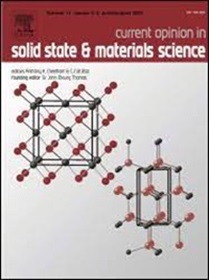History, present status, and future directions of vanadium alloys for fusion reactors
IF 13.4
2区 材料科学
Q1 MATERIALS SCIENCE, MULTIDISCIPLINARY
Current Opinion in Solid State & Materials Science
Pub Date : 2025-04-27
DOI:10.1016/j.cossms.2025.101224
引用次数: 0
Abstract
Since the need for low-activation fusion reactor materials was recognized in the mid-1980s, vanadium alloys have been researched and developed as promising candidates for blanket structural materials. Vanadium alloys are non-ferromagnetic and ductile materials and thus have advantages different from other candidates. However, since vanadium alloys are still at a premature industrial stage, research and development have been carried out not only on issues specific to fusion reactors but also on those related to industrial materials. Blankets using vanadium alloys as structural materials and liquid Li as a tritium breeder and coolant (self-cooled V/Li blankets) have unique characteristics, and research and development of issues specific to V/Li blankets have been conducted in conjunction with the development of vanadium alloys. In this paper, the progress of this research and development is reviewed, and the remaining issues are pointed out. Furthermore, the future direction of vanadium alloy research and development is discussed, considering recent changes in the environment surrounding fusion energy.
核聚变用钒合金的历史、现状及未来发展方向
自20世纪80年代中期人们认识到对低活化聚变反应堆材料的需求以来,钒合金作为一种有前途的包层结构材料得到了研究和开发。钒合金是非铁磁性和延展性材料,因此具有不同于其他候选材料的优势。然而,由于钒合金还处于工业发展的初级阶段,因此不仅针对核聚变反应堆的具体问题进行了研究和开发,而且还涉及到与工业材料有关的问题。以钒合金为结构材料,液态锂作为氚增殖剂和冷却剂的电热毯(自冷式V/Li电热毯)具有独特的特点,针对V/Li电热毯的研究与开发一直是在结合钒合金的发展进行的。本文综述了该领域的研究进展,并指出了存在的问题。最后,结合当前聚变能环境的变化,对今后钒合金的研究与发展方向进行了展望。
本文章由计算机程序翻译,如有差异,请以英文原文为准。
求助全文
约1分钟内获得全文
求助全文
来源期刊

Current Opinion in Solid State & Materials Science
工程技术-材料科学:综合
CiteScore
21.10
自引率
3.60%
发文量
41
审稿时长
47 days
期刊介绍:
Title: Current Opinion in Solid State & Materials Science
Journal Overview:
Aims to provide a snapshot of the latest research and advances in materials science
Publishes six issues per year, each containing reviews covering exciting and developing areas of materials science
Each issue comprises 2-3 sections of reviews commissioned by international researchers who are experts in their fields
Provides materials scientists with the opportunity to stay informed about current developments in their own and related areas of research
Promotes cross-fertilization of ideas across an increasingly interdisciplinary field
 求助内容:
求助内容: 应助结果提醒方式:
应助结果提醒方式:


